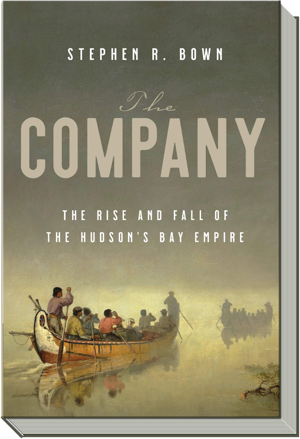The Company
The Rise and Fall of the Hudson's Bay Empire
Winner of the 2021 J.W. Dafoe Prize! ...
Learn MoreWinner of the National Business Book Award.
Excerpt
A thrilling new telling of the story of modern Canada's origins.
IN 1670, THE HUDSON'S BAY COMPANY was a small English business with a handful of primitive outposts along the western shore of Hudson Bay, trading practical manufactured goods for furs with the Cree of inland Subarctic Canada. One hundred and fifty years later, its trading posts populated the subarctic lowlands south and west of Hudson Bay, the tundra, the Great Plains, the Rocky Mountains and the misty forests of the Pacific Northwest. The Company, having inadvertently linked into a sophisticated web of intercontinental travel and commerce that involved dozens of Indigenous nations over countless thousands of kilometres, transformed the culture and economy of Indigenous groups from Montreal to Vancouver Island and ended up as the most powerful political and economic force in northern and western North America-even founding the cities of Winnipeg, Edmonton and Victoria, among others.
Yet for most of its existence the Company, governed by several dozen well-connected English aristocrats, seldom directly employed more than five hundred workers. Although the Company was an English corporation, its investors in London and its first employees from the British Isles, it later became inextricably linked with the peoples of the lands where it operated. It contracted Iroquois and French-Canadian voyageurs from Montreal and Métis from the Red River country. For countless generations its customers, suppliers and contract workers were the Indigenous peoples who were also friends, associates, competitors, wives and extended family to all levels of Company employees. Over time, it became a widespread domestic institution, an indelible part of the economic and social fabric of northwestern North America.
King Charles II had granted his cronies a grandiose charter and monopoly absurd in its scope and geographical misunderstanding- absolute mercantile authority in English law over a territory that encompassed the entire watershed of Hudson Bay, some four million square kilometres of land, over 40 per cent of the later territory of Canada, including all of northern Ontario and Quebec, all of Manitoba, southern Saskatchewan and southern Alberta and a good portion of the states of North Dakota and Minnesota. The region held nearly half the world's supply of fresh water in a vast lowland of swamps, ponds and lakes, and was home to at least ten million beavers, then extremely valuable for their pelts. The Company was not a colonizing enterprise- nothing in its charter had do with missionaries or conquest-but nor was it a purely business enterprise. While commercial transactions for profit were its primary objective for the first century and a half of its existence, it also had other responsibilities, such as searching for the fabled route to Cathay, "by meanes whereof there may probably arise very great advantage to us and our Kingdome."
The interior of North America in the 1670s was bewildering and unknown, and it was decades before the Company began to appreciate the political and cultural complexity of its trading monopoly. Word of the Company's arrival spread quickly, and people began canoeing the rivers to its forts or factories along the Hudson Bay coastline each year. The Cree who dwelt closest to the Company outposts along the bay, and eventually the Assiniboine and Chipewyan, became the brokers of the trade, operating their own jealously guarded monopolies and using the Company as a wholesale distributor, while passing on goods to Indigenous peoples farther inland.
After generations of mutually beneficial trade, knowledge and technology had been shared both ways, and many Company employees, including people of mixed genetic and cultural heritage, had learned the secrets of inland travel and survival. When faced with competition from traders of the North West Company coming west from Montreal in the 1780s, the Company moved inland and competition intensified. For most of its life the Company competed most vigorously for the right to thrive without competition.
The Hudson's Bay Company and the North West Company each sought to dominate the other, with various Indigenous peoples taking sides as the situation evolved, playing the companies off against each other for better terms of trade. The British government forcibly merged the two companies in 1821 under the old name of the Hudson's Bay Company. Eventually its monopoly was extended to the Pacific Ocean, to include the new states of Oregon, Idaho and Washington and the province of British Columbia. By the time the monopoly was rescinded, in 1870, after two hundred years, and the Company's territory transferred to the new country of Canada, the Hudson's Bay Company had realigned the economy of northern North America.
The Company's history is not a story of heroes and villains, though certainly there were heroic and villainous characters; it is much more nuanced. History is not a single narrative, but rather many competing and intertwining narratives blending and striking off from each other. In evaluating such a monumental entity and its profound influence on the development of a large portion of North America, the variables are nearly overwhelming. Do we follow the storyline of the uneducated field workers; the aristocrats and financiers in London; the multitude of Indigenous trappers, traders and entrepreneurs; the predominantly Cree wives of the Company's immigrant European workforce; the European fur merchants and hat makers; the famous pathfinders and travellers; the governing overseas directors; or perhaps even the hapless beavers? To focus too predominantly on one storyline effectively sidelines others. I have taken a broad interpretation of who the people of the Company were and have cast the net wider, to include a more diverse group of people who influenced, and were influenced by, the Company over the years of its life as a monopoly during the monumental exchange that endured for two hundred years.

